How To Repair Torn Drywall Surface
How to Repair Torn Drywall Paper
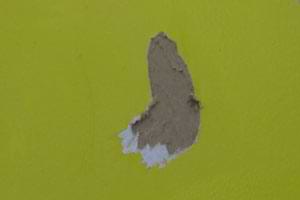
Drywall paper can be damaged when a wall is gouged while moving piece of furniture or other common household activities. Water tin also damage drywall newspaper, causing the surface to pucker and ripple. This can happen when removing wallpaper with a liquid stripper or when a leaking pipage or roof permit water to damage walls and ceilings.
The nearly important part of repairing impairment like this is sealing it and so it doesn't absorb any moisture from the repair chemical compound and touch-up paint. If you don't seal the surface, the repair procedure will cause the undamaged layers of paper to bubble and ripple again and no amount of sanding will fix the problem. Use the following procedure for a trouble-free repair of torn drywall paper and bank check here for a video demonstrating how to repair torn drywall newspaper.
Cut Away the Harm
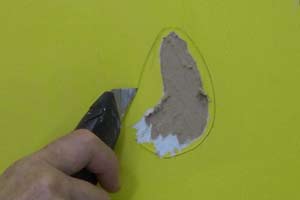
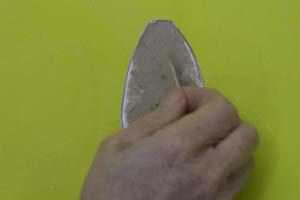
Cut all the torn or puckering newspaper away from the gypsum. Cut cleanly around the perimeter with a precipitous utility knife or a razor blade. Tilt the bract out a footling to cutting at a slight angle through the paper. Gently skin the rough fringes of loose paper complimentary, leaving a smoothen surface behind.
If simply the first few layers of newspaper are affected, cut down to the first undamaged layer. Otherwise, remove all the damaged and peeling paper from the gypsum cadre.
Seal the Drywall Paper
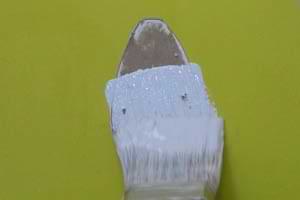
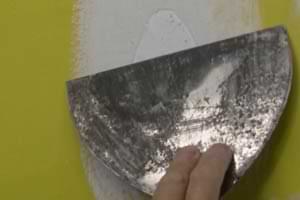
Cover the exposed gypsum and surrounding wall with a thick glaze of oil or shellac primer-sealer. Stir the sealer or milk shake the can first to exist sure information technology's mixed well and then apply two very thick coats with a brush. Let the primer dry out for well-nigh an hour betwixt coats and let the final glaze dry completely earlier proceeding.
When the 2nd coat of sealer is dry, utilise a joint pocketknife to smooth out the raised paper fibers so they don't stick up and interfere with the repair chemical compound. Go over the surface once or twice with the blade in a downward stroke to flatten the fibers out.
Utilize a Glaze of Joint Compound
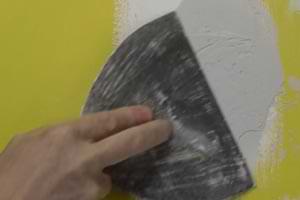
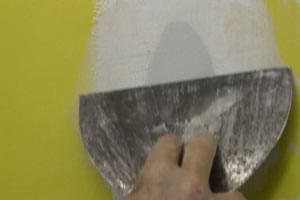
Mix some setting-type joint chemical compound, besides chosen mud, and apply information technology to cover the damaged expanse. Apply a thick coat over the damage and surrounding wall. Holding the joint pocketknife at an bending, "butter" the surface with back and forth strokes to go out about 1/8th inch coat of mud.
Immediately go back over the area to skim the excess mud from the surface leaving a thin coat covering the impairment and surrounding area. Concur the knife at a 30° angle and printing downwards hard merely not difficult plenty to dig into the surface as you skim from ane side to the other. Scrape the collected mud from the pocketknife onto the rim of a mud pan with each laissez passer and get over the whole surface area in parallel strokes.
Ignore any ridges left by the blade border, these will be removed after the mud has stale. Around the perimeter of the repair, skim the mud as thin every bit possible to blend it into the surrounding wall. Let the mud ready for about 30 minutes or until it has completely hardened.
When the mud has gear up, shave off whatever ridges with upward strokes of the knife bract. Follow with medium grit sandpaper to lightly sand the whole patch, smoothing out any other bumps or protrusions. At the edges, sand to feather information technology with the surrounding surface.
Apply a 2d Glaze of Joint Chemical compound
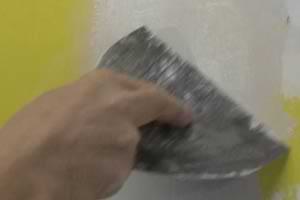
Wipe the sanding dust off with a damp rag and utilise a second coat of mud. Cover with a thick glaze and then skim off the excess stroking in the contrary direction from the outset coat. If you skimmed the get-go coat vertically, smooth the adjacent with horizontal strokes. This will help to level out an uneven surface in your repair.
Permit the mud dry and if necessary, apply another coat to build upwardly the patch, hiding the damage while besides smoothing out the area. Every bit before, shave off any ridges first and sand before skimming the patch again. With each new coat, stroke in the contrary direction from the previous application.
Sand and Touch Upwardly the Pigment
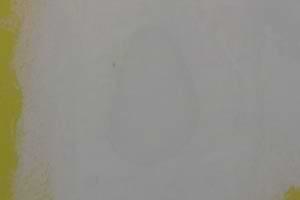
Let the final coat of mud dry out well and then sand it using light force per unit area in wide back and forth strokes to smoothen and blend the surfaces. Along the edges, sand harder to plumage the patch with the finished wall surface but avert excavation in. Wipe the sanding dust away with a damp rag being careful non to wipe abroad the finished patch.
Let the moisture from the rag dry and prime the patch. If you are using flat latex finish pigment, it will be cocky-priming. If y'all are using semi-gloss or other shiny paint, prime with apartment latex paint or a latex primer first before touching up the wall paint.
- How to Repair Bubbling Pigment
- How to Repair Torn Drywall Paper
- Repairing Water Damaged Drywall
- Repairing H2o Damaged Plaster
- Repairing Aging Plaster
- Repairing Major Plaster Damage
- Repairing Woods Board Plaster
- Repairing Drywall Nail Pops
- Repairing Minor Wall Holes
- Repairing Large Wall Holes
- Repairing Large Ceiling Holes
- Repairing Pocket-sized Ceiling Holes
- Repairing Wall and Ceiling Cracks
- Repairing Cracks with Expanding Foam
- Installing a Drywall Ceiling
- Finishing Recessed Drywall Joints
- Finishing Metal Drywall Corner Bead
- Finishing Newspaper Corner Dewdrop
- Finishing Inside Drywall Corners
- Finishing Drywall Butt Joints
- How to Do Drywall Texturing
- Skim Blanket on Walls and Ceilings
- Sanding Drywall Joint Compound
- Wall Tools and Materials Guide
How To Repair Torn Drywall Surface,
Source: https://www.do-it-yourself-help.com/repairing-torn-drywall-paper.html
Posted by: lewisyedis1951.blogspot.com


0 Response to "How To Repair Torn Drywall Surface"
Post a Comment